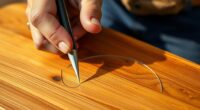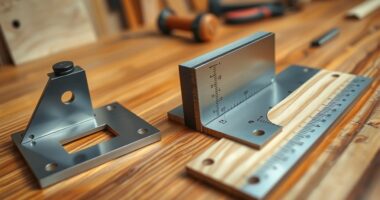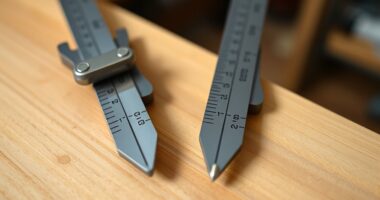Dovetail markers are essential tools that help you achieve consistent angles in your joinery projects. They act as precise guides, ensuring your cuts are accurate and joints align perfectly. Using these markers with templates simplifies transferring angles, reducing guesswork and errors. They help produce tight-fitting, professional-looking dovetails that enhance your project’s strength and appearance. Keep exploring to discover how these simple tools can make your woodworking projects more precise and enjoyable.
Key Takeaways
- Dovetail markers provide precise angle guidance, ensuring consistent and accurate joinery cuts.
- They simplify transferring template angles, reducing measurement errors in dovetail joints.
- Adjustable markers accommodate various dovetail slopes for versatile woodworking projects.
- Using markers with templates improves joint alignment, strength, and visual appeal.
- They streamline the dovetail cutting process, enhancing efficiency and professional results.

Have you ever wondered how skilled woodworkers achieve perfectly fitting joints? It’s a combination of precise measurement, steady hands, and the right tools. One of the key factors in creating flawless dovetail joints is maintaining perfect joint alignment throughout the process. When your angles are off, even slightly, the joints won’t seat properly, which can compromise both the strength and appearance of your project. That’s where dovetail markers come into play. They act as consistent angle guides, helping you cut dovetails with precision every time. These tools are designed to ensure your angles are uniform, making your dovetails fit seamlessly without the need for excessive fitting or adjustments.
Using dovetail markers simplifies the process of transferring angles from your woodworking templates onto your workpieces. Woodworking templates are invaluable because they provide a reference for consistent cuts, especially when producing multiple joints. With a dovetail marker, you can quickly mark the angles that match your template’s specifications, reducing guesswork and variability. Instead of relying solely on your eye or complex measuring, the marker acts as a visual guide, aligning perfectly with your template’s angles and ensuring your cuts are true. This consistency is critical when working on projects that demand high precision, such as furniture or cabinetry, where every joint must align flawlessly.
The beauty of dovetail markers lies in their straightforward design and ease of use. You simply position the marker in accordance with your template’s angle, and it guides your saw or chisel along the correct path. Many markers are adjustable, allowing you to set the exact angle you need for your project, whether it’s a standard 1:6 or 1:8 dovetail slope, or a custom angle for a specific joint. This adaptability ensures that no matter what project you’re working on, your joints will be consistent and professional-looking. Plus, because the marker helps maintain proper joint alignment, you’re less likely to make errors that lead to weak or misaligned joints, saving you time and frustration.
In essence, dovetail markers serve as reliable, repeatable guides that improve your accuracy and confidence. They help you produce tight-fitting joints by ensuring your angles stay consistent from cut to cut. When paired with well-made woodworking templates, these markers streamline your workflow, making complex dovetail joints less intimidating and more accessible. As a result, your projects will not only look better but will also be stronger and more durable. Whether you’re a seasoned woodworker or just starting out, incorporating dovetail markers into your toolkit can elevate your craftsmanship, helping you achieve the perfect joint alignment every time.
Frequently Asked Questions
Can Dovetail Markers Be Used for Other Types of Joinery?
Yes, you can use dovetail markers for other types of joinery, but their primary design is for dovetails. For alternative marking techniques, you might explore angle gauges or square guides that suit different joints. Keep in mind, dovetail markers are most compatible with dovetail joinery, so for joinery compatibility across various projects, consider tools tailored for each specific joinery type to guarantee accuracy and efficiency.
What Materials Are Best for Making Dovetail Markers?
You should choose durable materials like metal options such as aluminum or steel for making dovetail markers, as they resist wear and provide accuracy. Alternatively, hardwoods like maple or oak are excellent wood types because they’re sturdy and easy to work with. These materials guarantee your markers stay precise over time, making your joinery consistent and professional-looking. Always pick a material that suits your project’s durability and precision needs.
How Do Dovetail Markers Improve Accuracy in Woodworking?
Think of dovetail markers as your woodworking compass, guiding you through precise alignment. They help you maintain consistent measurements and angles, making your joints more accurate. With these tools, you avoid guesswork, reducing errors and ensuring each dovetail fits perfectly. This consistency leads to stronger, cleaner joints and saves you time reworking pieces. Ultimately, dovetail markers give you confidence in your craftsmanship, turning complex joinery into a straightforward task.
Are Dovetail Markers Suitable for Beginner Woodworkers?
Yes, dovetail markers are suitable for beginner woodworkers. They help improve accuracy and make sure consistent angles, making your joinery stronger and more precise. When using them, prioritize woodworking safety by wearing safety gear and handling tools carefully. Also, choose markers with good tool ergonomics to reduce fatigue and improve control. This way, you’ll build skills confidently while maintaining a safe, comfortable woodworking experience.
How Do I Maintain and Calibrate My Dovetail Markers?
To maintain and calibrate your dovetail markers, regularly clean them with a soft cloth to remove dust and debris. Check the angle settings periodically, using a protractor or digital angle finder as part of your calibration techniques. Adjust the markers carefully to ensure consistent angles, tightening any screws or clamps as needed. Proper dovetail marker maintenance guarantees accurate joinery and prolongs the tool’s lifespan, making your woodworking projects more precise.
Conclusion
With dovetail markers, you’ll find your joinery becoming as smooth as a well-tuned orchestra. These guides act like trusty compass needles, pointing you straight toward precision and perfect fits. No more guessing or frustrating rework—just clear angles leading to flawless connections. Embrace these tools, and watch your woodworking projects come together like a symphony of craftsmanship. With dovetail markers by your side, you’re well on your way to creating joins that stand the test of time.









